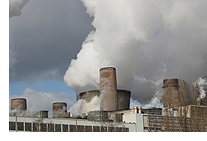|
||||||||||||||
Energy
production from carbon based fuels – the technology In
the context of the Stern Review, energy production from carbon-based fuels
is important for two reasons: it is the dominant method of energy production
i.e. electricity generation and it is a major contributor of carbon dioxide
and other greenhouse gases causing global warming. With fossil fuels other
products include particles which can alter the earth’s absorption
of heat and light and thus in fact alter the biosphere’s capacity
to capture carbon dioxide. In
the context of the Stern Review, energy production from carbon-based fuels
is important for two reasons: it is the dominant method of energy production
i.e. electricity generation and it is a major contributor of carbon dioxide
and other greenhouse gases causing global warming. With fossil fuels other
products include particles which can alter the earth’s absorption
of heat and light and thus in fact alter the biosphere’s capacity
to capture carbon dioxide.Generation of electricity using any of the fossil fuels relies on the same chemical process of combustion, and thus essentially requires a combustion chamber (furnace) in which the fuel with appropriate supply of oxygen is burned to release heat energy which is then used to do work. In most cases this involves heating a fluid which can be used to turn a turbine and thus a generator. The principle of using heat from fossil (or bio) fuel demands what is called a thermal power station. Energy production consists of a number of stages (each of which USES energy itself):
|
||||||